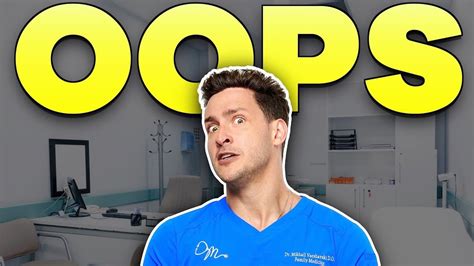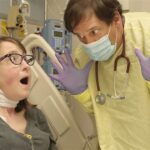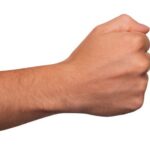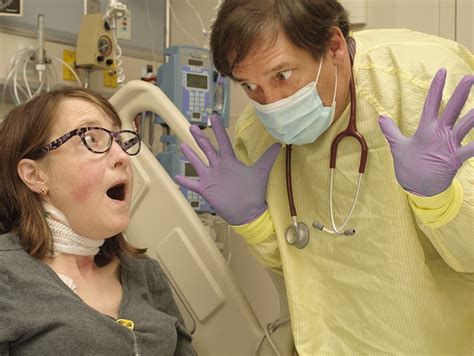
Doctors, nurses, and EMTs are sharing their most unbelievable patient encounters, ranging from bizarre foreign object removals to head-scratching medical mysteries, revealing the often-unseen absurdities and challenges within the healthcare system.
Healthcare professionals navigate a world far beyond routine check-ups and common ailments, encountering situations that test their skills, patience, and even their sense of disbelief. In a recent online discussion, doctors, nurses, and EMTs divulged some of their most memorable, and sometimes shocking, patient stories, offering a glimpse into the extraordinary realities hidden behind hospital doors and ambulance bays.
The tales range from the comical to the concerning, highlighting the diverse and unpredictable nature of medical emergencies and the human condition. One recurring theme involved the removal of foreign objects from bodily orifices. “I once removed a toy lightsaber from a patient’s rectum,” recounted a physician, remaining anonymous to protect patient privacy. Such incidents, while often humorous in retrospect, require careful and delicate handling to avoid further injury. Another medical professional shared a story of extracting “a fully intact corn on the cob” from a similar location, underscoring the baffling decisions some individuals make.
Beyond the realm of lodged objects, healthcare workers also described puzzling medical presentations. One nurse recalled a patient who insisted she was allergic to the color purple, displaying hives whenever she saw it. While the nurse acknowledged the potential for psychological factors influencing physical symptoms, she admitted the case remained a perplexing anomaly. EMTs, too, contributed their share of unusual stories, recounting instances of patients feigning medical emergencies for attention or transportation, diverting crucial resources from genuine crises. “We had a frequent flyer who would call for an ambulance complaining of chest pain, only to ask us to take him to his favorite fast-food restaurant,” one EMT stated.
These anecdotes, while entertaining, serve as a stark reminder of the pressures and complexities faced by healthcare professionals daily. They illustrate the need for adaptability, resourcefulness, and a healthy dose of humor to navigate the often-unpredictable landscape of patient care. The shared experiences also foster a sense of camaraderie among healthcare workers, providing a platform to vent, learn, and find solidarity in the face of challenging circumstances.
The stories also reveal deeper insights into societal issues, such as mental health struggles, substance abuse, and socioeconomic disparities. Many of the recounted incidents stemmed from underlying issues that extended far beyond the immediate medical complaint. The healthcare system, in many ways, functions as a safety net, catching individuals facing a myriad of personal and social challenges.
One doctor recounted a particularly poignant experience with a homeless patient who repeatedly sought treatment for minor ailments. After several encounters, the doctor discovered that the patient was primarily seeking shelter and human connection. The doctor was able to connect the patient with social services, providing him with access to housing and mental health support. This case highlights the importance of a holistic approach to healthcare, recognizing that physical well-being is often intertwined with social and emotional factors.
The online discussion also touched upon the ethical dilemmas that healthcare professionals frequently encounter. Doctors and nurses are often forced to make difficult decisions in high-pressure situations, balancing patient autonomy with their professional responsibilities. One nurse described a case involving a Jehovah’s Witness patient who refused a life-saving blood transfusion. The nurse struggled with the ethical implications of respecting the patient’s wishes while knowing that it could lead to their death. Such situations underscore the importance of clear ethical guidelines and open communication within healthcare teams.
The sharing of these extraordinary patient stories serves multiple purposes. It provides a form of catharsis for healthcare professionals, allowing them to process and reflect on their experiences. It also offers valuable lessons in adaptability, problem-solving, and empathy. Furthermore, it sheds light on the challenges and rewards of working in the healthcare field, potentially inspiring future generations to pursue careers in medicine. The stories also serve as a reminder of the importance of compassion and understanding in all interactions, both within and outside of the healthcare setting.
The sheer variety of experiences shared highlights the diverse patient populations that healthcare workers serve. From rural communities to urban centers, healthcare professionals encounter individuals from all walks of life, each with their unique set of circumstances and challenges. This exposure broadens their perspectives and fosters a deeper understanding of the human condition.
One rural doctor described a memorable experience treating a patient who had been injured in a farming accident. The doctor, who was the only physician in the small town, had to improvise using limited resources to stabilize the patient before an ambulance could arrive. This experience underscored the importance of resourcefulness and adaptability in rural healthcare settings.
In contrast, an urban nurse recounted a harrowing experience working in a busy emergency room during a mass casualty event. The nurse had to triage patients, prioritizing those with the most critical injuries. This experience highlighted the importance of teamwork, communication, and composure under pressure in high-stress environments.
The willingness of healthcare professionals to share these stories, often anonymously, underscores the importance of creating a safe and supportive environment where they can openly discuss their experiences. This can help to reduce burnout, improve job satisfaction, and ultimately enhance the quality of patient care.
The discussions also touched on the impact of social media on healthcare. While social media can be a valuable tool for sharing information and connecting with patients, it also presents challenges related to patient privacy and misinformation. Healthcare professionals must be mindful of these challenges and adhere to strict ethical guidelines when using social media.
One doctor described a situation where a patient posted a negative review online after a minor disagreement. The doctor was unable to respond publicly due to patient privacy concerns, which led to frustration and a feeling of helplessness. This case highlights the importance of developing strategies for managing online reputation and addressing patient concerns in a professional and ethical manner.
The article serves as a powerful reminder of the human element in healthcare. Behind every diagnosis, treatment, and procedure, there are individuals with their own stories, fears, and hopes. By sharing these stories, healthcare professionals humanize the healthcare experience and foster a deeper connection with their patients. It is a reminder that beyond the science and technology, healthcare is ultimately about people helping people.
The narratives underscore the necessity of empathy in the medical field. Healthcare professionals are often confronted with patients who are vulnerable, scared, and in pain. By approaching each patient with compassion and understanding, they can create a more positive and healing environment.
One nurse described a memorable experience comforting a young child who was afraid of getting a shot. The nurse took the time to explain the procedure in a way that the child could understand and offered reassurance and encouragement. This simple act of kindness helped to alleviate the child’s fear and make the experience less traumatic.
The compilation of these tales emphasizes the unpredictable nature of the healthcare field and the resilience of those who work within it. Each day presents new challenges and opportunities, requiring healthcare professionals to be constantly learning, adapting, and growing.
One EMT recounted a story of delivering a baby in the back of an ambulance. The EMT, who had never delivered a baby before, had to rely on his training and instincts to safely assist the mother. This experience highlighted the importance of being prepared for anything and the satisfaction of making a life-saving difference.
In conclusion, the candid stories shared by doctors, nurses, and EMTs provide a unique and valuable glimpse into the world of healthcare. They highlight the challenges, rewards, and unexpected moments that shape the lives of those who dedicate themselves to caring for others. The experiences shared serve as a reminder of the importance of compassion, resilience, and adaptability in the face of adversity. It also underscores the profound impact that healthcare professionals have on the lives of their patients and the communities they serve.
Frequently Asked Questions (FAQs)
-
What types of stories are healthcare professionals sharing?
Healthcare professionals are sharing a wide range of stories, including bizarre foreign object removals, puzzling medical presentations, instances of patients feigning medical emergencies, ethical dilemmas, and heartwarming moments of compassion and connection. The stories often highlight the unpredictable nature of the healthcare field and the diverse patient populations that healthcare workers serve. As one doctor stated, the stories include everything from “removing a toy lightsaber from a patient’s rectum” to dealing with patients who “call for an ambulance complaining of chest pain, only to ask us to take him to his favorite fast-food restaurant.”
-
Why are these stories being shared publicly?
These stories are being shared publicly for several reasons. Firstly, they provide a form of catharsis for healthcare professionals, allowing them to process and reflect on their experiences. Secondly, they offer valuable lessons in adaptability, problem-solving, and empathy. Thirdly, they shed light on the challenges and rewards of working in the healthcare field, potentially inspiring future generations to pursue careers in medicine. Finally, they serve as a reminder of the importance of compassion and understanding in all interactions, both within and outside of the healthcare setting.
-
What do these stories reveal about the healthcare system?
The stories reveal deeper insights into societal issues, such as mental health struggles, substance abuse, and socioeconomic disparities. Many of the recounted incidents stemmed from underlying issues that extended far beyond the immediate medical complaint. The healthcare system, in many ways, functions as a safety net, catching individuals facing a myriad of personal and social challenges. The stories also highlight the ethical dilemmas that healthcare professionals frequently encounter and the importance of clear ethical guidelines and open communication within healthcare teams.
-
How do these stories impact healthcare professionals?
These stories have a significant impact on healthcare professionals. Sharing their experiences can help to reduce burnout, improve job satisfaction, and foster a sense of camaraderie. It also allows them to learn from each other and develop strategies for coping with challenging situations. The stories serve as a reminder of the importance of compassion, resilience, and adaptability in the face of adversity. They also highlight the profound impact that healthcare professionals have on the lives of their patients and the communities they serve.
-
What are the ethical considerations when sharing these stories?
The primary ethical consideration when sharing these stories is patient privacy. Healthcare professionals must ensure that they do not reveal any information that could identify a patient, such as their name, age, location, or specific medical details. Many healthcare professionals choose to share their stories anonymously to protect patient confidentiality. They must also be mindful of the potential for social media to be used to identify patients and adhere to strict ethical guidelines when using social media. The discussions also highlight the importance of maintaining professional boundaries and avoiding the exploitation of patient stories for personal gain. The focus should always be on learning from the experiences and promoting a better understanding of the healthcare system and the challenges faced by healthcare professionals.
-
How does this article emphasize the importance of human connection in healthcare?
The article underscores the necessity of empathy in the medical field. Healthcare professionals are often confronted with patients who are vulnerable, scared, and in pain. By approaching each patient with compassion and understanding, they can create a more positive and healing environment. One nurse described a memorable experience comforting a young child who was afraid of getting a shot. The nurse took the time to explain the procedure in a way that the child could understand and offered reassurance and encouragement. This simple act of kindness helped to alleviate the child’s fear and make the experience less traumatic. Many similar narratives in the article emphasize the impact a medical professional’s demeanor and investment in the patient can have, making experiences less clinical and more about addressing a fellow human being.
- What role does humor play in these shared medical stories?
Humor is a coping mechanism in the often stressful and emotionally taxing field of healthcare. The stories shared often contain elements of dark humor or irony, which allows healthcare professionals to process difficult or absurd situations. While maintaining professionalism and empathy is crucial, finding humor in certain scenarios can prevent burnout and foster a sense of camaraderie among colleagues. The shared laughter becomes a bonding experience, reinforcing the shared understanding of the unique challenges they face. It allows them to acknowledge the absurdity without diminishing the seriousness of their roles.
- How are social and economic factors reflected in the medical narratives?
Many of the stories highlight the impact of social and economic factors on patients’ health and access to care. Incidents involving homeless patients seeking shelter, individuals with limited resources unable to afford necessary medications, or those with inadequate access to preventive care underscore the disparities within the healthcare system. These narratives serve as a stark reminder that health is often intertwined with social determinants, and that healthcare professionals must be aware of these factors to provide effective and equitable care. They often find themselves addressing not just medical symptoms but also the social and economic circumstances contributing to the patient’s condition, connecting them with social services and resources to address the underlying issues.
- What kind of training and mental preparation do medical professionals have for the unexpected situations they encounter?
Medical professionals undergo extensive training to prepare them for a wide range of medical emergencies and unexpected situations. This training includes classroom instruction, simulation exercises, and hands-on clinical experience. They learn to assess patients quickly, make critical decisions under pressure, and perform life-saving procedures. However, the article highlights that no amount of training can fully prepare them for the bizarre and unpredictable nature of some patient encounters. Adaptability, resourcefulness, and a healthy dose of humor are also essential qualities for navigating the challenges of the healthcare field. Moreover, healthcare institutions are increasingly recognizing the importance of mental health support for their staff, providing counseling services and peer support groups to help them cope with the emotional toll of their work.
- Do the shared anecdotes reveal any common themes or patterns in patient behavior?
Yes, the shared anecdotes do reveal certain common themes and patterns in patient behavior. One recurring theme is the tendency for patients to delay seeking medical care until their condition becomes severe. This delay may be due to a variety of factors, including fear of diagnosis, lack of insurance, or simply not wanting to bother the doctor. Another common pattern is the tendency for patients to self-diagnose and self-treat, often based on information they find online. While the internet can be a valuable source of information, it can also lead to misinformation and inappropriate self-treatment. Finally, the stories reveal a tendency for some patients to exaggerate their symptoms or feign medical emergencies in order to obtain attention, medication, or other benefits. These patterns underscore the importance of patient education and communication, as well as the need for healthcare professionals to be skilled at discerning the truth from fiction.
- How do these stories contribute to a better understanding of the role of EMTs in emergency medical care?
The stories shared by EMTs shed light on their crucial role as first responders and their diverse responsibilities. They highlight that EMTs are not just transporters of patients but also skilled medical professionals who provide on-site assessment, stabilization, and treatment in emergency situations. The anecdotes demonstrate their ability to handle a wide range of medical crises, from trauma injuries to cardiac arrests, often in challenging and unpredictable environments. Moreover, the stories reveal the emotional toll that EMTs face, as they are often the first to witness the aftermath of accidents, violence, and other traumatic events. They underscore the importance of providing EMTs with adequate training, support, and recognition for their vital role in the healthcare system. As one EMT shared, they often deal with situations where “patients feign medical emergencies for attention or transportation, diverting crucial resources from genuine crises,” highlighting the need for discernment and resource management.
- Do the medical professionals ever feel judged by society based on the unusual situations they handle?
While there isn’t explicit mention of societal judgment, the anonymity sought by many professionals suggests a concern for public perception. Sharing these stories can make them vulnerable to judgment from those outside the medical field who may not fully understand the pressures and complexities of their work. The desire to protect patient privacy further complicates the situation, as they are often unable to provide a complete explanation of the circumstances surrounding a particular incident. The focus on sharing experiences among themselves suggests a need for validation and understanding from peers who can relate to the challenges they face, which could indicate a perceived lack of understanding from the general public.
- What are some of the long-term impacts on medical professionals who deal with extreme or rare cases regularly?
Dealing with extreme or rare cases regularly can have several long-term impacts on medical professionals. It can lead to increased stress levels, burnout, and compassion fatigue. The emotional toll of witnessing suffering and death on a regular basis can be significant, and it can be difficult to detach emotionally from these experiences. Some medical professionals may develop post-traumatic stress disorder (PTSD) as a result of their exposure to traumatic events. On the other hand, dealing with extreme cases can also lead to increased resilience, adaptability, and problem-solving skills. It can also foster a deeper sense of purpose and satisfaction in their work. Many medical professionals develop strong coping mechanisms and support systems to help them manage the challenges of their profession.
- How do the healthcare professionals navigate language and cultural barriers when dealing with unusual cases or conditions?
Navigating language and cultural barriers is a common challenge for healthcare professionals, especially when dealing with unusual cases or conditions. Language barriers can make it difficult to obtain a complete medical history, explain treatment options, and ensure that patients understand and follow instructions. Cultural barriers can influence patients’ beliefs about health and illness, their willingness to seek medical care, and their adherence to treatment plans. To overcome these barriers, healthcare professionals often rely on interpreters, translators, and cultural liaisons. They also strive to be culturally sensitive and respectful of patients’ beliefs and values. It’s also crucial to leverage visual aids, demonstrations, and other non-verbal communication techniques to enhance understanding. The importance of building trust and rapport with patients, regardless of their language or cultural background, remains paramount.
- What are the potential benefits of creating a more open and supportive environment for healthcare professionals to share their experiences and challenges?
Creating a more open and supportive environment for healthcare professionals to share their experiences and challenges can have numerous benefits. It can reduce stigma associated with seeking mental health support, encouraging them to address their stress and burnout. Open communication can lead to improved teamwork and collaboration, as healthcare professionals learn from each other’s experiences and develop strategies for coping with challenging situations. This improved communication can also lead to better patient care, as healthcare professionals are better able to understand and respond to patients’ needs. Furthermore, a supportive environment can enhance job satisfaction and reduce turnover, leading to a more stable and experienced workforce. Finally, open sharing of experiences can help to identify systemic issues within the healthcare system and promote positive change.









